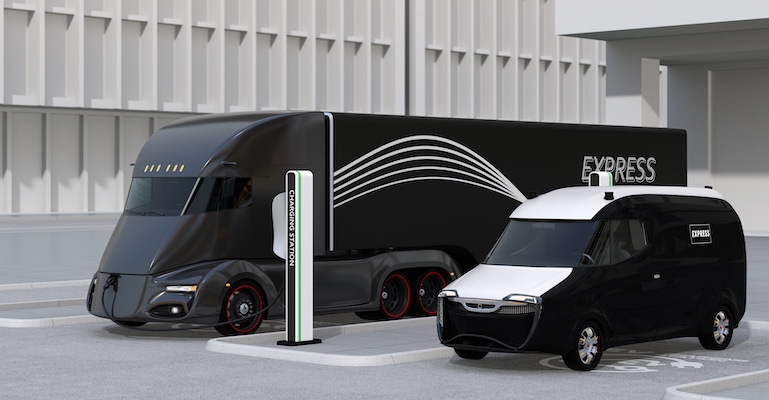Electric Delivery Vehicles: Is There a Best Time for Charging?
Optimizing the way in which electric delivery vehicles are charged can reduce costs and greenhouse gas emissions.
July 14, 2021

Electric vehicles (EVs) are getting a lot of attention with new battery-powered sedans, crossovers, SUVs, and pickup trucks rapidly coming online. Although EVs only make up about 2 percent of US sales at the moment, the push is on and the numbers will increase significantly in the 2025 to 2030 time frame. As powerful as the growth of personal EVs might be, the rise of online shopping, overnight shipping, and nearly instant delivery is providing an opportunity for electric delivery fleets to dramatically reduce the emission of greenhouse gases (GHGs).
Electric Delivery Fleets
Because the transportation sector is the biggest GHG contributor in the US, the potential to switch the nation’s fleet of delivery vehicles is interesting. In 2019, Amazon announced plans to obtain 100,000 electric delivery vehicles, UPS has ordered 10,000 EVs, and FedEx plans to be fully electric by 2040. Thanks to a study from the University of Michigan, we now know that the charging practices for electric vehicle fleets—both the source of the electricity for charging and optimizing the charging strategies can have a large effect on the lifetime GHG emissions from the vehicles.
Clean Energy
Perhaps the most obvious result from the Michigan study is that “charging from a cleaner energy source—such as an electrical grid with lots of renewables—is one of the most impactful ways to lower the emissions of an electric vehicle.” That said, even charging an electric delivery vehicle using a power grid in the most carbon-intensive regions of the United States results in fewer greenhouse gas emissions than their gasoline or diesel counterparts. The U-M team also found that “charging practices that shorten a battery’s lifetime will lead to early battery replacement, adding to the total greenhouse gas emissions associated with that vehicle.” If both charging and battery degradation were considered, the researchers found that greenhouse gas emissions could be lowered by as much as 37% by optimizing charging strategies.
“Our evaluation strategy leads to two main recommendations for companies investing in fleets of electric vehicles,” said Maxwell Woody of U-M’s Center for Sustainable Systems in a University news release. “The first is to consider battery degradation when determining when to charge and how much to charge. Some charging strategies can extend battery lifetime, and this will both lower greenhouse gas emissions and protect the company’s investment.”
The U-M team’s second recommendation to fleet owners is to consider the source of the energy used to charge the vehicle. “Considering the charging source can help companies determine the best places to charge, as local grids vary across the country. Companies should prioritize fleet electrification in regions that provide the greatest carbon-reduction benefits,” said Woody.
When Makes a Difference
The U-M research included a modeling study that analyzed four charging strategies and looked at their lifetime environmental impacts. The results indicated that a baseline charging scenario where a vehicle is fully charged immediately upon returning to a central depot results in the highest GHG emissions. “Charging the vehicle as soon as it returns and charging the vehicle up to 100% result in a lot of time spent sitting at the depot/charging station with a full battery,” said U-M researcher Parth Vaishnav, assistant professor at the U-M School for Environment and Sustainability. “This extra time spent fully charged will cause the battery to wear out more quickly—so quickly that the battery may need to be replaced sometime in the vehicle’s lifetime. Creating this additional battery produces additional greenhouse gas emissions, as well as additional costs.”
Sufficient Charging
Charging the battery by an amount that is just enough to complete the day’s route, (a practice the researchers called sufficient charging), was found to lead to an increase in battery lifetime—in some cases more than doubling it. Without having to replace the vehicle’s battery during its lifetime reduces the emissions tied to battery production and employing alternative charging methods could lead to emissions reductions of 8% to 37%.
In fact, delaying charging until the vehicle was close to departure, combined with sufficient charging, was the optimal strategy for both cost and emissions. “The most important finding is that there is a big opportunity here to lower emissions,” said Greg Keoleian, U-M professor of environment and sustainability and director of the U-M Center for Sustainable Systems. “Electric delivery vehicles only make up a small proportion of delivery vehicles right now, but that number is expected to increase in the coming years. Establishing the best practices for charging now, as these vehicles are starting to be deployed in larger numbers, is a critical step toward lowering greenhouse gas emissions.”
Kevin Clemens is a Senior Editor with Battery Technology.
About the Author(s)
You May Also Like





